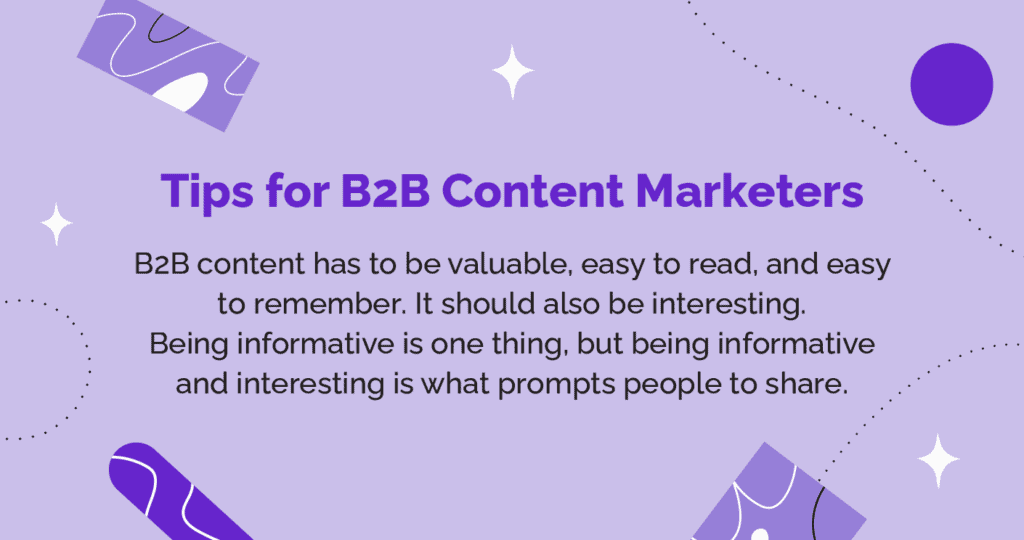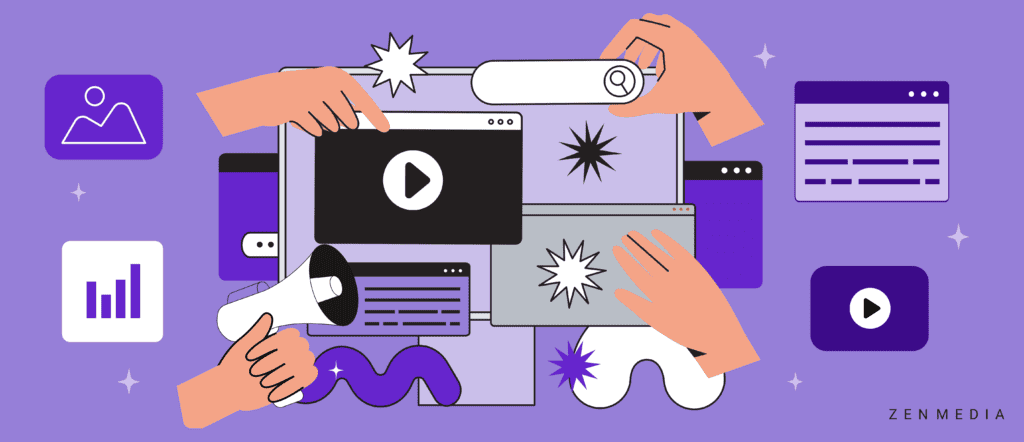When it comes to digital marketing, it can seem like B2C marketers have all the fun. They can talk directly to consumers, tell gripping stories in their blog to tug at their audience’s heartstrings, and push out one hilarious Facebook post after another. They’re the ones who can get away with being informal, lively, and entertaining. There’s just no way for professional, serious B2B marketers to put that much fun into their straightforward marketing content—or is there?
In reality, B2B and B2C marketers have a lot of common goals, and there’s no reason why B2B marketers can’t have some fun with their content marketing, too. The key is to find the right tone and to make sure that your content writing is still on-brand and relevant to your target audience. The key? Balance fun with content that is both informative and entertaining.
Understanding B2B Content Marketing
B2B content marketing is a fancy term that essentially means creating and sharing useful content with other businesses. It’s a bit like showing off your expertise and trying to build trust with your potential customers. But instead of bombarding them with sales pitches, you’re giving them something they actually want—valuable information!
This could be anything from blog posts and infographics to videos and webinars. The idea is to create content that resonates with your target audience and addresses their needs. By doing this, you can establish yourself as an authority in your industry and guide potential customers through their buying journey.
The great thing about B2B content marketing is that it’s not just about selling products or services, it’s about building relationships and providing value to your audience. By doing this, you can generate more leads, build brand awareness, and ultimately drive revenue growth. But to be successful, you need to have a deep understanding of your target audience, a solid strategy, and a commitment to measuring and optimizing your results.
So, if you’re looking to stand out in a crowded market and win the hearts and minds of B2B buyers, then B2B content marketing could be the strategy for you!
The Differences Between B2B Content Marketing vs. B2C Content Marketing
The term “business-to-business” makes it sound like one impersonal entity transmits data and statistics to another impersonal entity. Still, in reality, behind every corporate façade, there are…people. Whether B2C or B2B, everyone is writing content for human beings.
Related Reading: The 17 Best Digital Marketing Campaigns of All Time
So why is there a huge difference between B2C and B2B content marketing? Why is it that B2C content tends to be more fun and engaging while B2B sometimes lands on the dull side?
Every business wants to be seen as an authoritative expert in its industry. And light-hearted humor just doesn’t convey that weight of authority.
Just as it wouldn’t be appropriate to wear flip-flops to work when everyone else is in a nice suit, it also isn’t appropriate to write a B2B blog post that’s nothing but emotion and humor. One of the biggest challenges in differentiating B2B marketing with B2C marketing lies in the buyer journey. B2C customers are typically buying smaller quantities for themselves or someone close to them. In B2B, buying decisions are more involved, so there needs to be substance in B2B content to generate leads and convince potential clients that you know what you’re talking about.
That being said, business people are all still humans. Just about every human would read something humorous, clever, or engaging rather than something dry and boring, even if it is about a critical business issue. It’s okay to crack some jokes at a business meeting—it helps break the ice and develop relationships.
So yes, B2B content needs to be more substantive, but that doesn’t mean you can’t have fun with it, either. To create an effective B2B marketing strategy, you need to combine the best of both worlds—valuable, authoritative information conveyed professionally, but written with humorous, or at least interesting, touches and in an approachable style.
Why Do You Need To Use B2B Content Marketing?

1. Businesses make up your target audience
Businesses have different requirements than consumers do. Therefore, they need to buy products and services differently. That means that you need to understand what makes businesses tick before you start advertising to them.
2. You get access to a larger market
Because businesses are buying products and services, they represent a much bigger potential market than consumers do.
3. You can reach decision-makers
Decision-makers make purchasing decisions. If you want to influence these people, then you need to advertise to them.
4. There is less competition
You don’t have to compete with other companies who are trying to sell to consumers. Instead, you only have to worry about competing with other businesses.
5. You can build more trust
B2B content marketing is all about building trust with your potential customers. By providing valuable and educational content, you can establish yourself as an industry thought leader and earn the trust of your target audience. This can lead to customer loyalty, referrals, and repeat purchases down the line.
6. Boost SEO

Creating high-quality content that is optimized for search engines can improve your website’s search rankings. This, in turn, can drive more traffic to your site and increase your chances of generating leads.
7. Drive engagement
Creating high-quality content that resonates with your audience can also drive engagement and keep your brand top of mind. The more engaged your audience is with your content, the more likely they are to consider your products or services.
8. Generate leads
B2B content marketing can be an effective way to generate leads for your business. By offering content that addresses your target audience’s pain points, you can capture their information and nurture them through the sales funnel.
9. Establish thought leadership

B2B content marketing can help establish your brand as a thought leader in your industry. By consistently creating high-quality content that provides value to your target audience, you can position yourself as an authority in your field.
10. Drive revenue growth
Ultimately, B2B content marketing can help drive revenue growth for your business. By building trust, generating leads, and establishing thought leadership, you can create a loyal customer base that will keep coming back for more.
Our Top 10 B2B Content Marketing Strategies
There are many reasons why you should consider using B2B content marketing. To help you craft the perfect content for your company, we’ve put together a list of our top 10 content marketing strategies to keep in mind as you write. Incorporate each one into your content, and you’ll be writing incredibly successful pieces of content in no time!
1. B2B content has to be valuable.

This is why stories and jokes can’t be the main focus of your content writing. What you write has to provide information of value to your target audiences. That information can be couched in a story, or peppered with jokes, but valuable information still needs to shine through as the main focus of the content. Make sure that every topic you write about will make a potential customer think, “Wow, I really do need to read that” when they see the title. If you can manage to do that, you’ll be well on your way to creating content that’s truly valuable to your readers.
According to a recent survey, 44% of respondents said improving the quality of the content led to marketing success. Additionally, 53% of marketers said they wanted to improve the quality of their content.
2. B2B content must be easy to read.
The type of people interested in reading B2B content are also the type of people who are busy running their own businesses, and who don’t have a lot of extra time on their hands. How do you catch the attention of B2B buyers and get them to slow down for just a minute to read your content in its entirety? Make it interesting. Using humor, brief stories, and a conversational style makes content easy and pleasant to read. Dry, boring content is more likely to be quickly skimmed rather than really read, which doesn’t make for an enjoyable—or memorable—experience.
Business buyers are also the type of people who appreciate valuable content. They want to learn something new, or find a new way to do something they’re already doing. So, make sure your content is packed with helpful information.
If you can do all of those things—make your content interesting, valuable, and relevant—you’ll have no trouble getting B2B buyers to take notice.
3. B2B content should be easy to remember.
Which are you more likely to effortlessly remember in great detail: a story about a company’s success once they began using a certain service or a list of facts and figures about that service? A gentle wisecrack about how much better a product is than the competition, or percentages and research showing the differences? Putting information into an entertaining form will always boost retention and help build trust with existing customers.
For example: when most people think of GEICO, they think of the gecko. This little green lizard has been the GEICO mascot for over 20 years, and he’s one of the most popular insurance company spokesmen in the country.
Why is the gecko so popular? Because he’s funny. He cracks jokes and makes people laugh, and that’s a big part of why GEICO has been so successful. People remember the gecko, and they remember the funny commercials he’s in. So if you want to create a successful marketing campaign, you should consider using humor. Humor is more memorable and more trustworthy than serious messaging, and it can help you connect with your audience on a deeper level.
4. B2B content needs to be easy to share and promote.

Business professionals are not going to waste their colleagues’ or clients’ time by sharing content with them that isn’t truly worthwhile. But they’re also much more likely to share something that really caught and then held their interest. Being informative is one thing, but being informative and interesting is what prompts people to share.
Making your B2B content easy to access and share is essential for getting the most out of it. By optimizing your content for search engines and social media, you can ensure your target audience can easily find it and share it with their networks.
To make your content more shareable, use social media buttons with clear and concise copy to encourage readers to share your content with their networks. You can also use social media widgets to showcase your latest content on your website or blog.
Related Reading: Reduce, Reuse, Repurpose, and Recycle Your Content
5. B2B content should get to the point.
Once again, busy business people have no time to waste. Even if a B2B blog post is captivating, it won’t matter if the reader can’t tell where it’s going after the first paragraph, and they’ll likely stop reading. Getting to the point doesn’t mean writing super short pieces of content or forgoing an interesting style—it simply means your stories and humor need to have a focus and a point, that’s clear from the get-go.
6. B2B content writing must be professional.
Just as in our flip-flop example above, there’s a time and a place for everything. Appropriate humor? Yes. Off-color or outright silly humor? No. Concise stories that illustrate a point? Yes. Rambling tales that don’t really seem to go anywhere? No. Think of B2B content as content in an office environment, while B2C content is content relaxing at home. What’s appropriate in one place may not be in the other.
For example, in an office environment, you might want to keep your language professional and your stories concise. In contrast, you can be a little more relaxed with your language at home and your stories can be a little longer.
The key is to know your audience and to write the type of content that’s most appropriate for them. When in doubt, always err on the side of professionalism. You never want your content to be so silly or off-color that it distracts from your message.
Related Reading: What Is High-Quality Content?
7. B2B content needs to be targeted.
Because B2B audiences tend to be more focused than B2C audiences, B2B content needs to be more narrowly targeted than B2C content. This can be a good thing, though, since you can analyze what your audience’s specific pain points are and then go after them in a very focused way. Likewise, your stories and humor can be tailored to resonate with your target audiences.
And remember that B2B audiences are usually decision-makers within their companies. This means the content you write must be of the highest quality to persuade them to take action. So take the time to create a well-crafted narrative that will capture their attention and help them see the benefits of doing business with you.
8. B2B content must be unique.
If someone can read your content without recognizing your unique voice, you’ve got a problem. To be considered authoritative, you’ve got to craft a voice that’s all your own. How do you accomplish this? By letting your personality shine through and adding touches of your brand of humor or storytelling skills.
When it comes to finding your voice, there’s no one right way to do it. The important thing is to be authentic to yourself. Let your personality come through in your writing, and don’t be afraid to inject a little bit of your flair. You want your readers to feel like they’re getting to know you and that they can trust what you have to say. Developing a unique voice is essential for anyone looking to build an audience.
9. B2B content should be based on analytics.
Not all writing styles are created equal. It could very well be that your first attempts at making your content more interesting won’t be received well by your audience. Most B2B content marketing takes some trial and error before the best course of action is settled upon, so don’t be afraid to experiment.
Make sure you’re delivering relevant content to your audience. Don’t just talk about things that you think are interesting—focus on the topics that your readers care about. If you can provide valuable information that is relevant to their needs, they’ll be more likely to stick around. Experiment with different techniques and watch your analytics. This will help you know when you’ve hit upon the right style for your particular audience.
10. B2B content must tie into your business’s overall marketing strategy and goals.
Finally, make sure that your writing style fits your company’s brand and that the type of content you’re putting out there has a specific purpose within the context of your overall B2B marketing strategy. Creating content just because everybody else is doing it won’t produce an ROI—only a carefully considered B2B content strategy that corresponds with your overall business plan will have the result you want it to have.
Types of B2B Content Marketing

B2B marketing channels are constantly evolving, but our roundup below explores six avenues every content marketer should explore to enhance their B2B digital marketing strategy.
1. Email marketing
Email marketing is still one of the best digital marketing channels today. Companies use email newsletters to share news updates, product announcements, promotions, events, etc. Research shows that users spend nearly 30 minutes per day reading their emails. By sending regular newsletters, you keep your subscribers updated on any changes in your industry, product offerings, or services.
2. Blogging
Blogging is another great way to reach out to your audience. You can write blogs on a wide range of topics, including making money, offering blogging tips, and much more. Not only does this provide you with additional information about your niche, but it gives you the opportunity to increase traffic back to your own site.
3. White papers
White papers are in-depth reports that provide valuable insights into a particular topic or issue. They are typically longer than blog posts and are designed to educate and inform your target audience. By offering white papers, you can showcase your expertise and establish credibility with potential customers.
4. Social media
Social media helps businesses build their brand online. By posting regularly on social media platforms like Facebook, X (formerly Twitter), LinkedIn, TikTok, Instagram, and Pinterest, brands create opportunities to engage current customers and attract potential ones. Social media posts can be an excellent way to trial fun and informative content, just make sure the message doesn’t get lost in the delivery.
As consumers become increasingly engaged with the companies they follow, these relationships grow into authentic, two-way conversations. And when people hear about a company’s products and services firsthand, they tend to trust what they read and learn. That means social media marketing efforts no longer simply work to help businesses reaches their target audiences, they also help to foster genuine customer engagement.
5. Webinars
Webinars are live or pre-recorded presentations that offer educational content to your target audience. They are a great way to engage with potential customers and provide them with valuable insights that can help them solve their business challenges.
6. Videos
Videos are an increasingly popular type of content that can be used to demonstrate your products or services, showcase customer testimonials, or provide educational content. TikTok has popularized short-form videos, but long-form content can still be valuable for websites and YouTube. By using videos in your B2B marketing efforts, you can engage your audience and build brand awareness.
By leveraging these six different types of B2B content marketing, you can create a comprehensive and effective strategy that resonates with your target audience and drives business results.
4 B2B Content Marketing Tools

1. Google Analytics
Google analytics is an excellent tool to help understand how people interact with your website. It tracks where visitors came from, what they do once they get there, and how long they stay before leaving. You can use these insights to improve your content marketing strategy.
2. BuzzSumo
BuzzSumo is a great way to find out which topics are trending online right now. Use their search bar to look for any topic and see what others are talking about. You can even create lists of keywords based on different industries.
3. Buffer
Buffer is a free service that lets you schedule posts across social networks. Once you have set up your post, you can share it at a time that suits you best. If you’re struggling to think of something to say, simply browse their curated list of ideas.
4. Hootsuite
Hootsuite is a social media management platform that makes scheduling content easier than ever. All you need to do is add each account you want to manage in one place and then choose when you would like to post. You can send pre-written messages or write your own using their drag-and-drop editor.
Best Examples of B2B Content Marketing
Mailchimp: Reality TV for content marketing
Mailchimp is an all-in-one marketing, automation, and email marketing platform. The platform created an in-house video production studio before COVID hit and it’s been successful since. Among the studio’s releases, Mailchip also created a reality TV-style series called Werrrk! Every 10-minute episode of Werrrk! focuses on a small business struggling to overcome a challenge.
Mailchimp’s Werrrk! is a great example of content marketing that catches the audience’s attention. Not only is it fun, but it’s short enough to keep the viewer from getting distracted. The content holds real value and provides the audience (mostly entrepreneurs) with actionable solutions that can be applied to their own businesses. Best of all, the content in these videos can be repurposed into blog posts, podcasts and more, proving that this is a great way to do enhance and recycle content marketing.
Wistia: The human element
The most important thing about content marketing is maintaining the human element. Wistia, a video hosting platform, is great at this. The brand shares visual content on Instagram that allows audiences to get a behind the scenes look at their people and dogs.
Not only does Wistia’s content align with their brand, it’s smart and holds a ton of value. Visual content is not to be neglected, and Wistia knows this as their viewer retention continues to grow at a fast pace. After all, who can scroll past a picture of a cute puppy!
HubSpot: Pioneers of B2B content marketing
HubSpot has both been teaching content marketing to others and practicing it themselves for over a decade. The platform is great because it sets a great example of how to diversify your content and experiment with it.
With all the content HubSpot creates—blogs, emails, videos, and more—the company places just as much importance in making sure their content makes sense and is reaching the right audience. While many businesses spam their social channels with the same content hoping for users to share, HubSpot makes an effort to begin a conversation. They capitalize on social media features such as Instagram stories and polls. Rather than just sharing links on X, they use the content to ask questions and spark conversations.
HubSpot’s willingness to explore new mediums and tactics has helped the company become one of the most successful and well-known marketing companies in the world. And there’s no doubt that HubSpot will continue to explore new opportunities in the years to come.
How Do You Measure the Success of Your B2B Content Marketing Strategy?

The best way to measure the success of a B2B content marketing digital campaign is to look at how much traffic it generates for your website. If your goal is to increase sales, then you want to focus on getting visitors who convert into leads. A lead is someone who has shown some level of interest in your product/service. To do this, you need to use conversion tracking tools such as Google Analytics to track which pages bring them to your site.
Now, It’s Your Turn
If you want your B2B content marketing strategy to be successful, you need to make sure that everything you produce is high quality, on-brand, and has a specific purpose. Before you start creating any content, you need to sit down and figure out what you want to achieve with your B2B marketing strategy. What are your goals? What are your targets? What are you trying to achieve? Once you have a clear idea of your objectives, you can start tailoring your content to meet those goals.
Need help writing better B2B marketing content? Talk to our experts.




